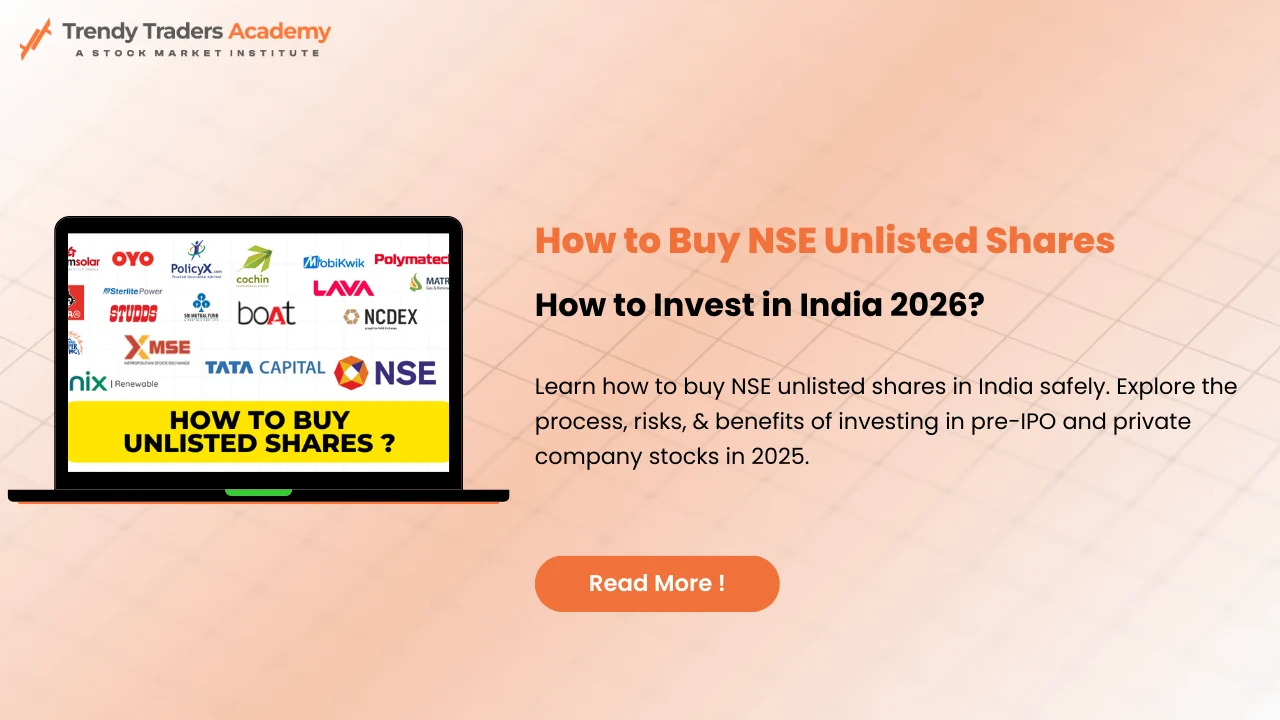
NSE Unlisted Shares Guide: Price, Trading & Opportunities
NSE Unlisted Shares: A Complete 3000-Word Beginner-Friendly Guide
Have you ever wondered how people buy shares of big companies before they get listed on the stock exchange? Or why investors often hunt for high-potential stocks even before the public gets a chance? Well, that’s exactly where NSE unlisted shares come into the picture.
Think of it like choosing your seat in a theater before the movie starts—you get more options, better prices, and sometimes, premium spots. But just like early bookings, it comes with a few risks too.
In this guide, we will break down everything in simple language so that even a complete beginner can understand how unlisted shares work, how to check NSE share price unlisted, why people invest in them, and how platforms like an online trading academy help you navigate this lesser-known but increasingly popular space.
Learn about nse unlisted shares, nse share price unlisted, and how an online trading academy helps you invest smartly in pre-IPO markets.
Understanding NSE Unlisted Shares
NSE unlisted shares are shares of companies that have not yet listed on the NSE (National Stock Exchange). They may be startups, established private companies, or even well-known brands preparing for a future IPO.
These shares are usually traded in the pre-IPO market, which is not accessible on regular apps like Zerodha, Groww, or Upstox.
In simple words:
Listed companies trade in the open exchange.
Unlisted companies trade privately.
How Unlisted Shares Differ From Listed Shares
Let’s break it down:
a) Transparency
- Listed shares: Fully regulated, price visible, highly transparent.
- Unlisted shares: Limited disclosures.
b) Price Movement
- Listed: Moves every second.
- Unlisted: Moves slowly, based on demand and supply.
c) Liquidity
- Listed: Easy to buy and sell.
- Unlisted: Harder to find buyers instantly.
d) Accessibility
- Listed: Anyone can buy.
- Unlisted: Only through authorized dealers.
Why Do Companies Issue Unlisted Shares?
Companies issue unlisted shares for several reasons:
- Raising funds before going public
- Employee stock options (ESOPs)
- Expansion without regulatory pressure
- Testing valuation before entering a full-fledged IPO
It’s like a rehearsal before the main show—companies can prepare themselves financially and structurally before a public listing.
Benefits of Investing in NSE Unlisted Shares
Why do investors love them? Here are real advantages:
a) Chance to Invest Before IPO
If a company becomes successful, your early investment can multiply.
b) Lower Valuations
Prices are often cheaper than the expected IPO price.
c) High-Growth Potential
Some unlisted companies may become future giants.
d) Portfolio Diversification
A great way to diversify beyond normal stock market investing.
Risks You Must Know
No investment is perfect. Here are the major risks:
a) Low Liquidity
Selling unlisted shares quickly is tough.
b) Price Manipulation
Since demand and supply control prices, fluctuations can be extreme.
c) Limited Information
Not all details are publicly available.
d) Company May Delay or Cancel IPO
This is common.
How to Check NSE Share Price Unlisted
Since unlisted shares don’t trade on NSE, you can’t check them in real-time.
Here’s how you can find the nse share price unlisted:
- Through unlisted brokerage platforms
- Contacting authorised dealers
- Marketplace portals specializing in pre-IPO shares
- Company’s financial performance updates
- Demand and supply trends
Unlisted prices tend to change weekly or monthly, not every second.
How to Buy NSE Unlisted Shares in India
This is easier than most people think.
Step-by-Step Buying Process
- Find a registered unlisted share dealer
- Complete KYC verification
- Choose the unlisted share you want to buy
- Get a quotation for the current price
- Make the payment via bank transfer
- Shares get transferred to your Demat account
That’s it—simple and straightforward.
Eligibility & Requirements for Investors
To invest in unlisted shares, you need:
- A Demat account
- A PAN card
- A bank account
- Basic KYC details
- An understanding of private market risks
You do NOT need special permissions or high net-worth status.
Real-Life Examples of Popular Unlisted Shares
Some well-known unlisted companies in India include:
- Tata Technologies (before listing)
- OYO
- Reliance Retail
- HDFC Securities
- Studds Accessories
- Swiggy
- Byju’s
- NSE (National Stock Exchange) itself
These companies often attract huge demand in the unlisted space.
How Valuation of Unlisted Shares Is Done
Since market price isn’t publicly available, valuation depends on:
a) Company financials
Revenue, profit, debt, customers.
b) Industry benchmarks
c) Growth potential
d) Demand and supply
Higher demand = higher unlisted share price.
Liquidity in the Unlisted Market
Unlike NSE, where shares sell within seconds, unlisted shares require:
- A buyer
- A negotiated price
- Time for completing transfers
It’s like selling property—you need a matching buyer. So be prepared for delays.
Taxation on Unlisted Shares
Tax rules for unlisted shares differ slightly.
Short-Term Capital Gains (STCG)
- If held for less than 24 months
- Taxed at individual income tax slab
Long-Term Capital Gains (LTCG)
- If held for more than 24 months
- Taxed at 20% with indexation
Role of Online Trading Academy in Learning Unlisted Market
An online trading academy plays a vital role for beginners by offering:
a) Courses on private market investing
Understand basics of unlisted shares.
b) Risk management training
Learn how to avoid major pitfalls.
c) Live case studies
Study real unlisted companies.
d) Valuation techniques
How to assess a company’s true worth.
e) Practical trading experience
Simulated unlisted market environments.
Learning before investing is always cheaper than losing money.
Common Mistakes Investors Make
Avoid these mistakes if you want to succeed:
a) Buying without research
Don’t rely solely on seller hype.
b) Investing all savings
Keep unlisted investing under 10–20% of your portfolio.
c) Ignoring the risks
High rewards come with high risks.
d) Assuming IPO will definitely happen
Nothing is guaranteed.
Final Tips & Best Practices
Here are the top tips:
- Always compare prices with multiple dealers.
- Choose companies with strong fundamentals.
- Be careful with startups—high risk.
- Hold for long-term for best returns.
- Keep learning through an online trading academy.
Conclusion
Investing in NSE unlisted shares is like stepping into a world where opportunities arrive early—sometimes too early. You get a chance to invest before the crowd, grab high-growth potential companies, and diversify your portfolio. But like every powerful tool, it requires caution, knowledge, and patience.
With the right information, smart research, and proper guidance from an online trading academy, you can make informed decisions and explore the unlisted market confidently.
FAQs
1. What are NSE unlisted shares?
These are shares of companies that haven’t listed on the NSE but are available for private buying and selling.
2. How can I check NSE share price unlisted?
You can check through unlisted share dealers, pre-IPO platforms, or financial analysis reports.
3. Is it legal to buy unlisted shares in India?
Yes, it is completely legal if done through verified platforms and proper documentation.
4. Are unlisted shares risky?
Yes. They have low liquidity, uncertain IPO timelines, and limited information. But rewards can be high.
5. Can beginners invest in unlisted shares?
Yes, but it’s recommended to learn basics via an online trading academy before investing.




